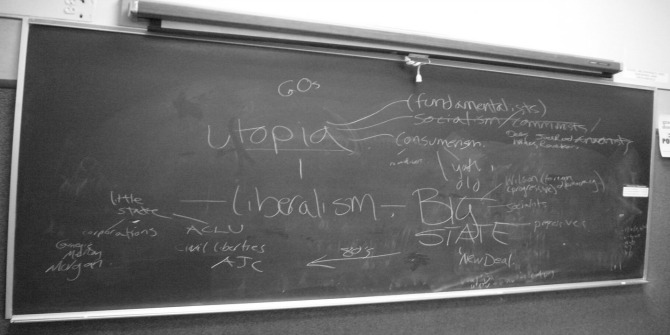 Abi Rhodes discusses the breadth of online and offline tactics employed by the UK movement groups The People’s Assembly Against Austerity and Extinction Rebellion in the 2015, 2017, and 2019 general elections. She argues that social movement-voter interaction is a key aspect of political communication.
Abi Rhodes discusses the breadth of online and offline tactics employed by the UK movement groups The People’s Assembly Against Austerity and Extinction Rebellion in the 2015, 2017, and 2019 general elections. She argues that social movement-voter interaction is a key aspect of political communication.
Social movements have long communicated with a broad range of audiences, including the general public, political parties, other civil society organisations and voters. At election times, social movements can be politically impactful by presenting messages that challenge (or reproduce) dominant ideas of the political environment and offer alternative arguments about what is to be done. These messages can target political parties during elections by articulating citizen demands that call for institutional and policy changes (movement-party interaction) and/or focus on drawing voter attention to a specific issue during election campaigns (movement-voter interaction). Despite this, the dimension of movement-voter interaction is currently absent from the fields of social movement studies and political communication where the literature tends to focus closely on institutional actors.
My research shows that focusing on the analysis of communicative tactics aimed directly at voters adds a self-consciously unmediated form of communication during elections to the study of political communication and the framework of electoral contention. It reveals that in the three UK general elections from 2015-19, two UK-based social movement groups – The People’s Assembly Against Austerity (PAAA) and Extinction Rebellion (XR) – engaged in movement-voter interaction to draw attention to austerity policies and environmental concerns respectively. Both XR and PAAA used a variety of tactics during these election campaigns to communicate with the electorate, including political billboards, hashtags, podcasts, and protest songs.
Each movement group engaged in movement-voter interaction to differing degrees. In the 2015 and 2017 general election campaigns, PAAA engaged solely in movement-voter interaction in adopting novel strategies to try to enter the political debate and reach the wider electorate. For example, the group’s crowdfunded anti-Conservative billboards represented Theresa May as a threat to jobs, public services, and security and the protest song Liar, Liar GE2017 described her as being unable to tell the truth. These specific tactics focused closely on asking people to not vote for her and the Conservatives, as they could not be trusted. In this way, PAAA’s messages engaged in ad hominem attacks and employed the process of delegitimisation to connect with the electorate. This illustrates that, in much the same way as traditional electoral campaigning, some movement-voter interaction conveys its message in a way that aims to highlight the weaknesses of an opponent instead of positively promoting the recognition of an issue.
In 2019, XR’s repertoire was broader and more expansive and included movement-party interaction, particularly in its use of climate hustings around their Three Demands Bill, hunger strikes outside Party HQs, and Bee-yond Politics, that saw activists dressed as bees glue themselves to party battle buses. The movement group employed similar communicative tactics to PAAA, including launching an election-focused hashtag (#ElectionRebellion), producing non-partisan billboards about casting your ballot, and releasing an election special podcast. But unlike PAAA, whose movement-voter interaction focused closely on asking people to not vote for politicians who could not be trusted, XR’s direct voter communication focused on a campaign for people to demand that politicians sign up to Three Demands Bill.
XR’s movement-voter interaction drew attention to the content and context of its own argument around the environmental emergency, rather than engaging in negative evaluations of other political actors. For example, the Severe Weather Warning tactic saw the actor Emma Thompson stand outside BBC headquarters in front of maps showing which London Tube lines and coastal areas around the UK were most at risk of flooding. Flanked by the activists dressed in goggles and swimming caps, Thompson delivered a mock weather forecast that emphasised the threat that rising sea levels, caused by climate change, posed to the UK. For XR, the flooding was a tangible event that rendered the climate emergency an undeniable fact in 2019 and one that resonated with voters affected by floods in the first two weeks of the election campaign. This communicative tactic sought to place the climate high on the political agenda by outlining the effects of the emergency. Indeed, each of their tactics highlighted climate issues and invited voters to place the environment front and centre when deciding who to vote for.
These examples and my research reveal that, through the use of various communicative tactics, both PAAA and XR attempted to impact public decision-making on who or what to vote for during the 2015, 2017, and 2019 general elections. Each attempted to raise awareness of their specific issues among the electorate in order to effect the political change that they sought and, in doing so, engaged in movement-voter interaction.
A key part of the argument here is that increasingly managed electoral messaging by communication consultants, and a perceived decline in institutional participation, including political party and trade union membership and electoral politics, have led to higher levels of cynicism and lower levels of engagement in the democratic process and political trust. Movement communication directed at voters could therefore reignite electoral participation, and analysis in this area presents researchers with an opportunity to build a broader and more comprehensive picture of political communication on electoral outcomes.
___________________
 Abi Rhodes is Teaching Associate in the Department of Culture, Languages and Area Studies at the University of Nottingham.
Abi Rhodes is Teaching Associate in the Department of Culture, Languages and Area Studies at the University of Nottingham.
Photo by Markus Spiske on Unsplash.







